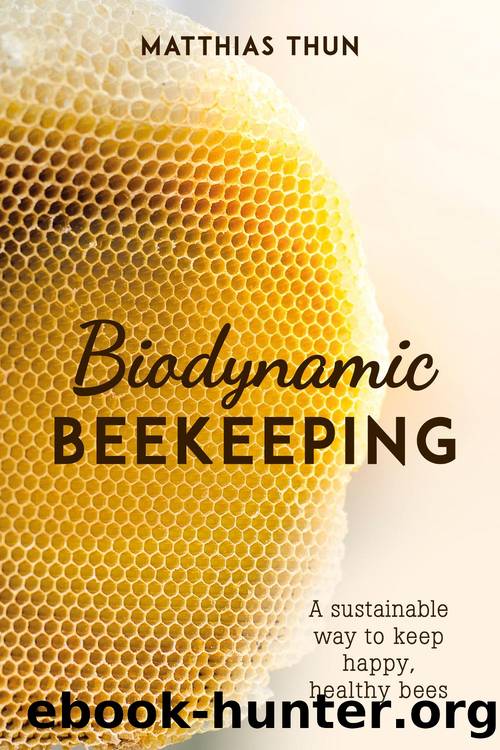Biodynamic Beekeeping by Matthias Thun

Author:Matthias Thun
Language: eng
Format: epub
Publisher: Floris Books
Published: 2020-10-15T00:00:00+00:00
Breeding in queen-right colonies
The rearing of queens in queen-right colonies is another option for queen reproduction. As criticism of artificial queen breeding has not yet ceased, some beekeepers have tried to make it more like natural queen reproduction. Queen reproduction in queenless colonies is of course very similar to the development of emergency queens. As it is generally known that supersedure queens can be very good queens, people have tried artificially to reproduce the supersedure mood. It is done in the following way. First, it requires a colony in a magazine hive with plenty of brood. The queen is confined to the lower box with a queen excluder. The brood nest is moved to the topmost box, the third box up. The queen excluder is covered with foil so as to leave open a narrow strip of 3â5 cm (1â2 in) as a passage through to the upper boxes. This greatly separates the queen and her brood nest, and by covering most of the queen excluder there remains only a little contact between the lower and upper boxes. The breeding frames with larvae are now hung between the combs in the brood nest that is now in the top box. The bees in the top box are so far from the queen that they actually accept some of the larvae and rear them into queens. But in terms of numbers, queen-right colonies raise fewer queens. However, with this method of queen rearing, the upper brood nest with its breeding frames needs checking for emergency queen cells after four or five days. If the connection with the queen in the lower box is too small, it may happen that the brood nest bees assume they are queenless and, to be on the safe side, make emergency queens. These have to be cut out as they will emerge sooner than the queens from the breeding frame, thus again risking the success of rearing, because the first emergency queen to emerge will bite into the other mature cells and sting the queens inside them.
Beginners in queen breeding will find it easier to learn breeding in queenless colonies and thereafter in queen-right colonies. Whichever method you finally adopt rather depends on whether you need a large number of queens, or whether a few will suffice.
These two accounts of queen reproduction in both queenless and queen-right colonies is only intended to show how it is possible to rear many queens. We have not discussed the various ways of bringing about better care of the developing cells. There is already sufficient published material that deals excellently with this theme.
Download
This site does not store any files on its server. We only index and link to content provided by other sites. Please contact the content providers to delete copyright contents if any and email us, we'll remove relevant links or contents immediately.
Machine Learning at Scale with H2O by Gregory Keys | David Whiting(4179)
Never by Ken Follett(3790)
Fairy Tale by Stephen King(3220)
Will by Will Smith(2792)
Hooked: A Dark, Contemporary Romance (Never After Series) by Emily McIntire(2500)
The Dawn of Everything: A New History of Humanity by David Graeber & David Wengrow(2122)
The Becoming by Nora Roberts(2087)
The Strength In Our Scars by Bianca Sparacino(1776)
HBR's 10 Must Reads 2022 by Harvard Business Review(1776)
A Short History of War by Jeremy Black(1762)
Go Tell the Bees That I Am Gone by Diana Gabaldon(1687)
515945210 by Unknown(1599)
A Game of Thrones (The Illustrated Edition) by George R. R. Martin(1589)
Bewilderment by Richard Powers(1539)
443319537 by Unknown(1470)
The 1619 Project by Unknown(1384)
The Real Anthony Fauci: Bill Gates, Big Pharma, and the Global War on Democracy and Public Health (Childrenâs Health Defense) by Robert F. Kennedy(1366)
How to Live by Derek Sivers(1319)
I Will Find You by Harlan Coben(1273)
